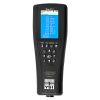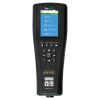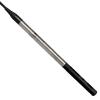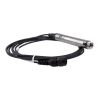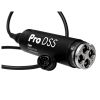YSI ProDSS Total Algae Sensor
Features
- Dual channel sensor
- Measures and outputs both chlorophyll & blue-green algae
- Options for ug/L and RFU outputs
- Free ground shipping
- Expedited repair and warranty service
- Lifetime technical support
- More
The Total Algae (TAL) sensors are dual-channel fluorescence sensors. The “channels” are for chlorophyll and phycocyanin (TAL-PC), or chlorophyll and phycoerythrin (TAL-PE), which are measured in the water. Each sensor thus yields two data sets: for TAL-PC, one results from a blue-emitting LED that excites the chlorophyll a (chl) molecule and the second results from an orange excitation beam that excites the phycocyanin (PC) accessory pigment. The TAL-PE sensor is similar, also having the chlorophyll channel, but rather than an orange-emitting LED there is a slightly blue-shifted beam that excites phycoerythrin (PE).
The TAL sensors generate data in RFU or μg/L of pigment (chl, PC or PE) units, with RFU as the default. When using either RFU or μg/L, the sensor’s response is highly linear: a reading of 50 of either unit represents twice as much fluorescence detected as a reading of 25, for example, if the temperature is constant.
ProDSS Smart Sensor Specifications:
| Parameter |
Range | Accuracy* | Resolution |
|---|---|---|---|
|
Conductivity |
0 to 200 mS/cm |
From 100 to 200 mS/cm: ± 1% |
**0.001, 0.01 or 0.1 µS/cm |
|
Temperature |
-5 to 70 °C |
± 0.2 °C |
0.1 °C or 0.1 °F |
| Dissolved Oxygen |
0 to 50 mg/L |
From 0 to 20 mg/L: ± 1% From 20 to 50 mg/L: ± 8% |
0.01 mg/L or 0.1 mg/L |
| pH |
0 to 14 |
± 0.2 |
0.01 |
|
ORP |
-1999 to 1999 mV |
± 20 mV |
0.1 mV |
| Turbidity |
0 to 4000 FNU |
From 0 to 999 FNU: ± 2% From 1000 to 4000 FNU: ± 5% |
0.1 FNU |
| Freshwater Total Algae |
0 to 100 µg/L PC |
r2 = 0.999 |
0.01 µg/L PC |
| Saltwater Total Algae |
0 to 280 µg/L PE |
r2 = 0.999 |
0.01 µg/L PE |
| Nitrate |
0 to 200 mg/L |
± 10% |
0.01 mg/L |
| Ammonium |
0 to 200 mg/L |
± 10% |
0.01 mg/L |
| Chloride |
0 to 1000 mg/L Cl |
± 15% |
0.01 mg/L |
*Reference specification for each sensor for more details on accuracy
** Range dependent
In The News
Handheld Cyanotoxin Detection Technology Prototype
In the battle against harmful algal blooms (HABs), time is important . The need for laboratory equipment and testing is a serious challenge for water managers. This issue caught the eye of Qingshan Wei , an assistant professor of chemical and biomolecular engineering at North Carolina State University . “Our research group is interested in developing low-cost sensors,” Wei told EM . “Recently we have been developing sensors for environmental monitoring, and cyanotoxins came to our attention .” Cyanobacteria, which generate HABs, are becoming a challenge across the US . They are a very serious problem in North Carolina, in part due to the weather.
Read MoreSolar and Wind-Powered, Algae Tracking Boat Trialed in Florida
Time is of the essence when it comes to tracking algal blooms, and people everywhere are looking for solutions. In Florida, scientists from Florida Atlantic University Harbor Branch Oceanographic Institute (HBOI) recently trialed a solar-powered, algae-tracking sail boat developed by Navocean , Inc. Dr. Jordon Beckler of Florida Atlantic University (FAU) directs HBOI's Geochemistry and Geochemical Sensing Lab and spoke to EM about the trials and the boat. "This boat is so amazing when you see it in action," remarks Dr. Beckler. "Navocean originally contacted me a few years back about a demonstration when I was over at my previous institution in West Florida, and we brainstormed some scenarios for employing the boat for harmful algae bloom monitoring.
Read MoreSafeguarding Communities with Real-Time Flood Monitoring in the City of Hazelwood
The City of Hazelwood is a suburb in St. Louis County, Missouri, home to around 25,500 people. Recently, the community has suffered increased flash flooding following severe storms, prompting the need for the installation of a flood monitoring system. In 2022, a NexSens X2 data logger was installed to monitor water level and rainfall in real-time, with the aim of reducing the loss of life and property as a result of extreme weather events. [caption id="attachment_39411" align="alignnone" width="940"] The latest flood event at Coldwater Creek, where the water level rose by 14 feet, exceeding the height of the X2 by three feet. The sensor can be seen behind the wall that usually contains the Creek.
Read More





